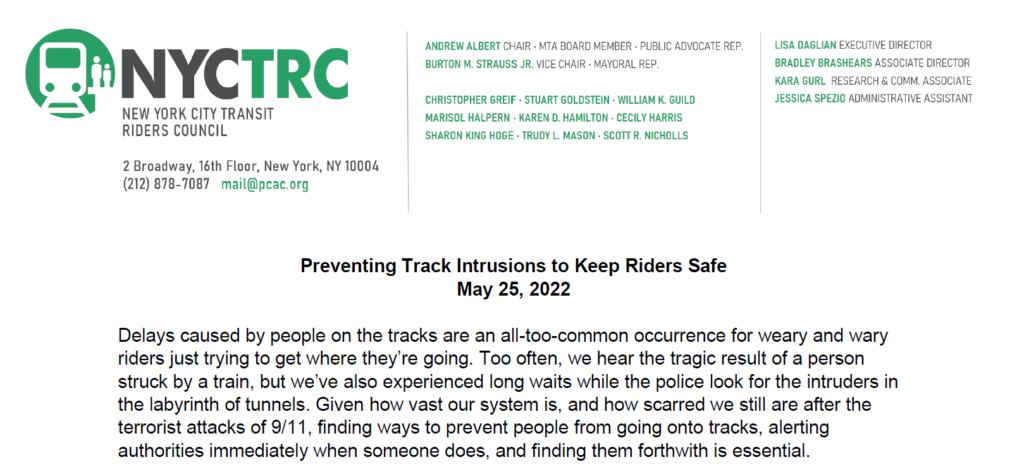Lisa Daglian, Executive Director of the Permanent Citizens Advisory Committee to the MTA (PCAC) and Andrew Albert, Chair of the New York City Transit Riders Council (NYCTRC) and MTA Board Member said:
Delays caused by people on the tracks are an all-too-common occurrence for weary and wary riders just trying to get where they’re going. Too often, we hear the tragic result of a person struck by a train, but we’ve also experienced long waits while the police look for the intruders in the labyrinth of tunnels. Given how vast our system is, and how scarred we still are after the terrorist attacks of 9/11, finding ways to prevent people from going onto tracks, alerting authorities immediately when someone does, and finding them forthwith is essential.
We’re glad to see that the MTA’s Track Intrusion Task Force has released their report, including multiple strategies and programs that will help keep riders safe on platforms and off of the tracks – and safe from those who do venture onto the tracks. In the months since the tragic death of Michelle Go, riders are visibly worried about voluntary and involuntary track intrusions—we’ve all seen more riders waiting for their trains while standing against the wall or behind columns, and we thank the MTA and the Track Intrusion Task Force for their commitment to solving this safety and service issue.
It’s good news that track intrusions decreased in April, but even one is too many and there is still much work to be done after a recent upward trend over the last few years. The more immediate approach outlined in the report ‒ an expanded messaging and communication campaign; suicide prevention partnerships; upgraded CCTV cameras with artificial intelligence and video analytics technology; more mental health workers across the system; and front-facing train cameras ‒ present a holistic approach to problem-solving. The partnership with the Transit Tech Lab will bring great minds to bear on these problems, and opportunities for solutions that include technologies that will be tried in field conditions. In the medium- and longer- terms, pilot programs and improvements like the laser intrusion detection system expansion, platform screen doors pilot, track intrusion detection system, blue lighting, and railroad right-of-way security can be transformative in preventing future track intrusions.
We’ll continue to emphasize that the MTA and city and state partners should use every tool in every toolbox to keep riders safe. With the improvements detailed in this report, it’s clear that the MTA’s toolbox is growing and advancing. We look forward to seeing the results of these improvements and pilot programs in the coming months and years and encourage the MTA to remain transparent and communicate with riders, advocates, and other stakeholders as these improvements are deployed. We remain hopeful that riders will feel and see a steady decline in the number of delays and safety incidents caused by track intrusions around the system.
CONTACT: Kara Gurl, PCAC: 718-839-3625/ [email protected] Lisa Daglian, PCAC: 917-612-2292/ [email protected]
